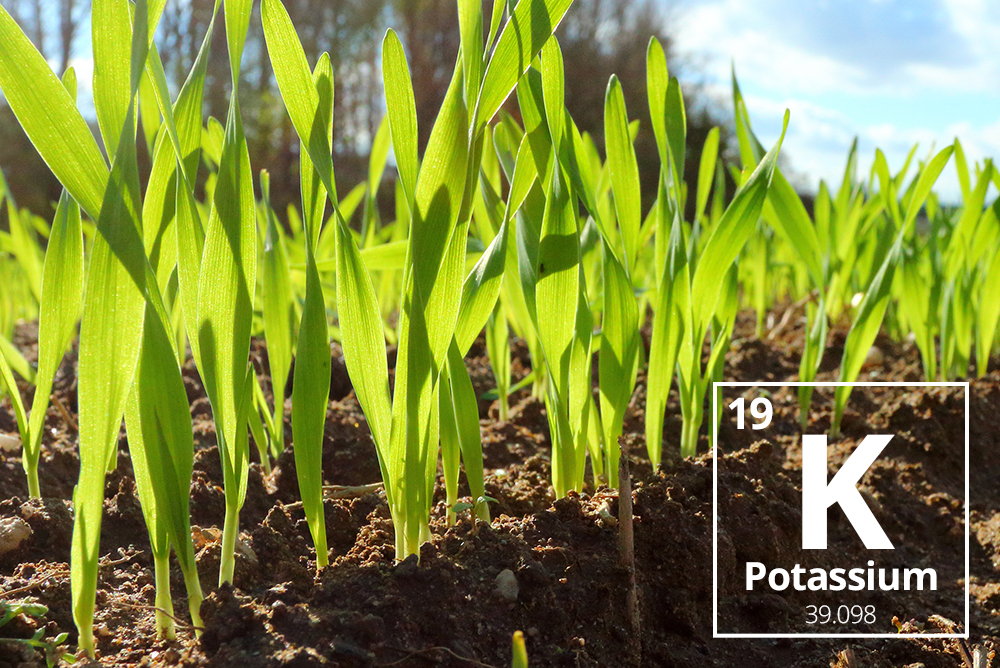
Agricultural Nutrient Profile: Potassium (K)-Part 2
Potassium availability in the soil
How do you determine potassium availability in the soil, and what factors can impact the uptake of K in crop production?
It begins by understanding that potassium exists in the soil in one of three forms: unavailable, readily available and slowly available to plants.
Unavailable potassium
The vast majority of potassium in the soil is unavailable to the plant. That is because it is playing another important role. Potassium, magnesium and calcium are all cations – positively charged elements. Cations are attracted to the negatively charged soil. This relationship helps provide structure to the soil. In fact, between 90-98% of the K in the ground is tied up in the soil structure – and is unavailable to plants.[1]
Most of the native potassium in the soil comes from two common minerals: feldspars and micas. Plants cannot utilize this insoluble, crystalline form of K. Over long periods of time these minerals weather or breakdown and K is released. However, this process is too slow to supply the needs of a crop during the growing season.
Readily available potassium (soluble and exchangeable K)
Plants can access and absorb potassium through the root system when this vital nutrient becomes available in the soil solution (read Part 1 to learn the role of K in plant development). As the concentration of K in the soil solution drops, it can be replenished by drawing additional potassium from exchange sites on the surface of clay particles.
Slowly available potassium (fixed K)
How does potassium reach these exchange sites? Reserves of K become trapped (or “fixed”) between layers in the clay. Only a small amount of this fixed potassium migrates to exchange sites throughout the growing season. Moisture is necessary to release these trapped K particles.
Slowly Available K
⇓⇑
Exchangeable K
⇓⇑
Readily Available K
In the above diagram, the arrows go both ways. The reason is that the soil is a dynamic system. K can convert back and forth between these three forms depending on a number of factors, including: root uptake, soil moisture and temperature levels, and the addition of new K via fertilizer.
Factors affecting crop available potassium
Potassium availability in the soil can be affected by a variety of factors.
Soil type: As we learned, potassium can get trapped in heavy clays. This allows it to hold potassium reserves which eventually can become available. In an article in Western Producer, John Heard, a soil fertility expert with Manitoba Agriculture, estimates 80% of the provinces clays have good supplies of K. It is common for sandy soils to be deficient, and these soils can greatly benefit from the addition of K.[2]
Soil moisture: Moisture is required to liberate fixed potassium and provide the soil solution necessary for plant intake. If the soil becomes too saturated, it will reduce oxygen availability (see below). In dry growing seasons, potassium fertilizer may prove necessary. K can also provide plants with some additional drought resistance.
Tillage Systems: Potassium uptake is reduced in no-till systems. It is thought that this is due to restricted root growth and distribution.
Soil temperature: Plants are shown to uptake K and other nutrients with greater efficiency when the soil temperature is between 16 °C and 27 °C. Potassium uptake is hindered in lower soil temperatures.
Aeration and O2 levels: Compacted soil that is low in oxygen impedes the roots from absorbing nutrients. Oxygen is also necessary for K uptake.
Next: Keys to successful potassium management in soil
In the final part of this series, we will explore how to soil test for K, and look at uptake and removal.
[1] https://www.extension.umn.edu/agriculture/nutrient-management/potassium/potassium-for-crop-production/

